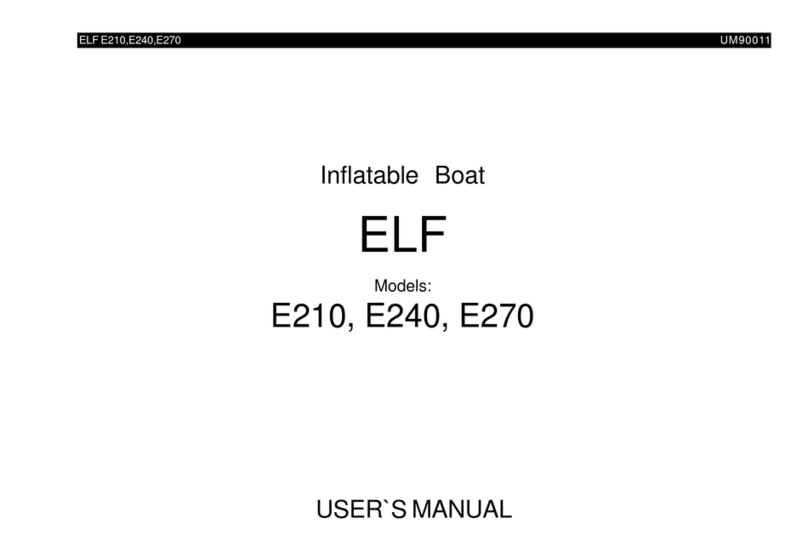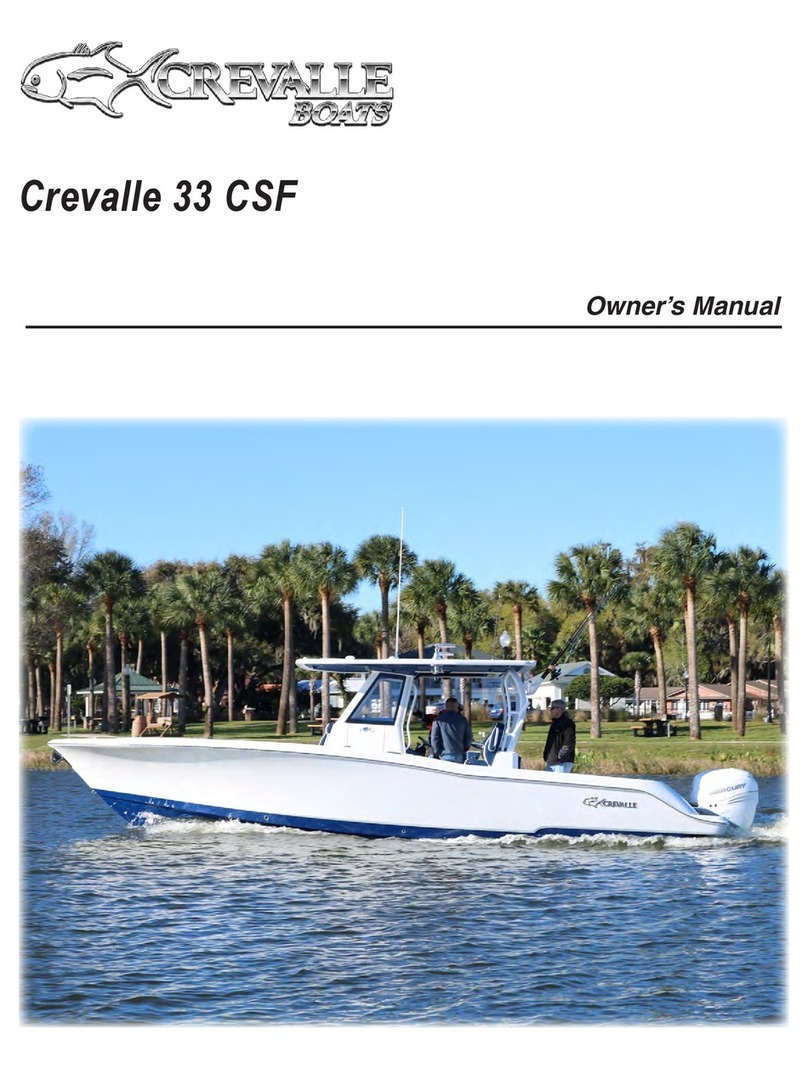Spitfire Sail Boat User manual

OWNERS MANUAL

Spitfire Owners Manual English
Introduction ___________________________________________________________ 5
List of Spitfire Catamaran parts ___________________________________________ 6
Main parts_________________________________________________________________ 6
Glossary ______________________________________________________________ 6
Dimensions____________________________________________________________ 7
Platform assembly ______________________________________________________ 8
Trampoline rigging _____________________________________________________ 9
Rigging the mast____________________________________________________ 10, 11
Setting up the rig and masting
Platform _________________________________________________________________ 13
Mast_____________________________________________________________________ 13
Raising the Mast___________________________________________________________ 14
Lowering the Mast_________________________________________________________ 15
Spinnaker bowsprit and boom
Bowsprit _________________________________________________________________ 16
Boom ____________________________________________________________________ 18
Setting up of outfitting and equipment
Trapeze__________________________________________________________________ 19
Mast Rotation_____________________________________________________________ 19
Traveller _________________________________________________________________ 19
Mainsheet and Mainsheet strop ______________________________________________ 20
Mainsail Downhaul ________________________________________________________ 20
Jib Sheet and Jib Strop _____________________________________________________ 20
Jib Downhaul _____________________________________________________________ 20
Righting Rope_____________________________________________________________ 21
Foils
Rudders__________________________________________________________________ 21
Daggerboards _____________________________________________________________ 21
Sails
Mainsail__________________________________________________________________ 22
3
Loday White Limited

Spitfire Owners Manual English
Jib ______________________________________________________________________ 23
Spinnaker ________________________________________________________________ 24
Tuning Guide __________________________________________________________26
Sailing Guide __________________________________________________________28
Capsize Recovery_______________________________________________________ 32
4
Loday White Limited

Spitfire Owners Manual English
Tuning Guide (Stuart Gummer)
0–8 knots 8–15 knots >15 knots
Dagger boards Upwind: Down
Downwind: ½Down Upwind: Down
Downwind: ½Down Upwind: Down
Downwind: ½Down, in >22
knots, lift all the way up
Diamonds Tension should be set such
that when looking up the
mast track about 1” of pre-
bend is observed (mast bends
backwards). Do not over
tighten the wire and we
suggest a maximum of35 on
a loose gauge. Lighter crews
generally rake the spreaders
back further. This allows you
to bend the mastmore and
flatten the sail further
therefore de-powering it.
Same as 0-8 knots Same as 0-8 knots
Jib Upwind: Cars set oninner
setting. Jib sheeted to touch
the roller onthe spreader.
Jib luff tension to take out
wrinkles.
Downwind: Set to tell tails
Upwind: Cars set oninner
setting. Jib sheeted to touch
the roller onthe spreader.
More jib luff tension
required.
Downwind: Set to tell tails
Upwind Cars set to middle
setting. Jib sheeted to touch
the roller onthe spreader.
More jib luff tension
required.
Main Upwind: Cunningham pulled
just to take wrinkles out of
sail, main sheeted without
hooking (closing off the top
of the leech). Spanner
pointing at shroud.
Downwind: Cunningham off,
don’t sheet main toohard,
but don’t let it loose.
Upwind: Once you are twin
wired and the boat is
constantly flying a hull you
can increase thecunningham
to stop the boat healing
excessively. Spanner pointing
at shroud.
Downwind: Cunningham off,
main sheeted quite tight, but
not as tight as upwind. Don’t
let it off as a way of de-
powering the sail use the
traveller. This will protect
your mast.
Upwind: Pull on cunningham
hard to prevent the boat
healing excessively. Spanner
pointing at shroud.
Downwind: Cunningham off,
main sheeted quite tight, but
not as tight as upwind. Don’t
let it off as a way of de-
powering the sail use the
traveller. This will protect
your mast.
Rake Take the trapeze wire and tie
some rope to the end of it,
pull the rope to the top of
the upper rudder mounting
plate. To measure the rake
take the rope forward to
touch the gelcoat seam on
the hull at the front of the
boat. Now measure the
distance between the back of
the bow tang and the end of
the rope as it touches the
seam. This should be 10 to 12
inches.
Same basic setting as 0-8
knots.
As wind speed increases
crews tend to rake the mast
further. To a maximum of 15
inches as measured
previously. Be aware that as
you alter the rake you will
also alter the spinnaker luff
tension and the height of
the Jib clew above the pole.
If don’t adjust these with
rake to keep them at their
optimum performance will
suffer.
Same as 10-15 knots.
Shrouds/Side Stays Tension onthe shrouds
should be loose enough for
the mast to rotate easily
towards the shrouds,
approximately 19on Loose
gauge . This should be
measured onthe shroud.
Tension on shrouds should be
20-24 on loose gauge
Same as 8-15 knots
Spinnaker Set up with luff tension so
that if you grab it in your
hand you can twist it 90
degrees. Toachieve this you
may have to adjust the
position of the pulley at the
head of the sail and/or alter
the band of the pole. To trim
ease until luff curls and then
sheet to stop the spinnaker
Same as 0-8 knotsSame as 0-8 knots
26
Loday White Limited

Spitfire Owners Manual English
collapsing, keeping the luff
almost curling at regular
intervals. Pull harder on
sheet during accelerationand
when boat is bearing away,
ease the sheet atthe end of
the puff.
Traveller Upwind: Centre
Downwind: Middle, don’t
sheet main toohard
Upwind: Centre
Downwind: Same as 0-8
knots. When the boat is over
powered and you have gone
bow down it may necessary
to release the main traveller
to help to de-power the boat
further. Do not release the
main sheet.
Upwind: Centre, > 22 knots
you may crack off traveller
an inch or two.
Downwind: Same as 0-8
knots
27
Loday White Limited

Spitfire Owners Manual English
Sailing Guide (Chris Sproat)
Please refer to the Tuning Guide for boat settings.
Light Winds
Upwind
Boat Trim Crew weight forwards. Crew on or in
front of front beam. Helm as close to the crew as
possible. This will stop the transom dragging. If there is
any intermittent trapezing it better that the crew should
do it. When one of you can remain out on the wire either
can trapeze depending onweight required. You are
aiming to keep the boat momentum going, to do this you
should avoid excessive tiller movement, keep crew
movement to a minimum and concentrate.
Mainsail tuning Remember to adjust the outhaul
from heavier weather settings to flatten foot of the sail as
you will not be using as much downhaul. If the wind
increases and you need to put more down haul on then
you may have to release the outhaul to prevent your
boom from bending excessively.
You may be surprised how much mainsheet tension is
required in light winds to control the top third of the sail
to gain power.
You may want to increase your batten tension if you
suspect a light wind day.
Constant adjustment of mainsheet tension will be
required as the wind strength varies.
Jib Tuning Adjust jib as per tuning guide. This may
require constant trimming.
Watch the lower two jib tell tails closely. Windward tell
tails lifting then you are pinching, if the leeward tell tail
is lifting then you are footing too much.
Dagger Boards Fully down
Tacking Using the tiller start gently and ease the
boat into the tack. Release the mainsheet at least a couple
of feet as you cross the midline. Keep the jib backed
until main battens have popped. Slowly squeeze the jib
and main back in as the boat accelerates away.
Bearing away You must maintain boat speed by
easing the boat in to a gentle turn. These are options
when time allows:
Lift windward dagger board early
Pull out spinnaker tack line
28
Loday White Limited

Spitfire Owners Manual English
If you are trapezing upwind keep the helm on the
wire and let the crew go in to do the necessary
jobs.
Release any downhaul.
Helm may need to move backwards to counter
the crew who will be forwards hoisting the
spinnaker.
If overpowered lower traveller as required.
Downwind
Boat trim Crew to leeward and moving to windward
as wind strength increases. For and aft trim level by
weight adjustment. Avoid excessive movements of crew
and tiller as upwind unless hit by a gust when it may be
necessary to bear away quickly to de-power.
Mainsail Don’t over sheet it. Remember if the wind
increases and you are bow down use to traveller to dump
power not the main sheet.
Jib Ease and set to tell tails.
Spinnaker During hoist you must go low until
spinnaker is fully up. It is useful to have a mark on the
halyard to indicate when this has been achieved. To trim
ease the sheet until the luff curls and sheet to stopthe sail
collapsing. Keep the luff almost curling by constant
adjustment. It may be necessary to sheet in if the boat
accelerates. The helm should keep the crew informed of
course changes so they can adjustthe sail appropriately.
Dagger Boards Half down
Jibing Before the jibe pull the jib over to the new
tack. A good time to jibe, if the opportunity arises, is at
the end of a bear away. Using the tiller ease the boat
round. In under five knots it may be necessary to ease the
main to allow the battens to pop. Do not release the
spinnaker from its current side until it starts to fill, now
release it and sheet on the new side. The jib should now
be released from the previous side and trimmed to tell
tails. Head up gently to build up speed.
The Drop Put the dagger boards down in
anticipation. During the drop bear away, do not release
the spinnaker sheet, (either kneel on it or give it to the
helm), make a bra out of the spinnaker by pulling the
retrieval line just before you release to halyard, continue
to pull down quickly until at least half of the spinnaker is
in the chute before you release the tack line.
Heading up Use the main and jib to control the turn
and squeeze on as you head upwind.
29
Loday White Limited

Spitfire Owners Manual English
Heavy Winds
Upwind
Boat Trim Crew weight adjusted backwards
to maintain fore and aft trim. If bow down and rudders
stalling you are too far forwards. In extreme conditions
you may have to get as far back as possible. You are
aiming to keep the windward hull kissing the waves. To
do this void excessive tiller movement, keep crew
movement sensible and concentrate.
Mainsail tuning To set the outhaul; first pull on a
reasonable amount of down haul, both trapeze, sheet the
main quite hard, if the hull flies excessively pull on more
down haul. The boom should now have a gentle camber.
If the boom is bent excessively you have got to much
outhaul on and conversely if there is no camber you need
to increase the outhaul. Downhaul is at a maximum
when the eyelet is touching the boom. You may have
to pull very hard to do this. This will open the top of
the sail, de-power it and enable you to point. The last
inch of downhaul is often crucial!
Constant adjustment of mainsheet tension will be
required as the wind strength varies.
Jib Tuning Adjust jib as per tuning guide. This may
require constant trimming.
Watch the lower two jib tell tails closely. Windward tell
tails will often lift. This OK as you are trying to balance
the boat to the wind conditions, if the leeward tell tail is
lifting then you are footing too much.
Dagger Boards Fully down
Tacking Using the tiller start gently and
ease the boat into the tack. You may need to release the
mainsheet further than in light winds as you cross the
midline. The jib will only need backing in choppy
conditions. Keep your weight forward. Slowly squeeze
the jib and main back in as the boat accelerates away.
Bearing away You must maintain boat speed by
easing the boat in to a gentle turn. These are options
when time allows:
Lift windward dagger board early
Pull out spinnaker tack line
If you are trapezing upwind keep the helm on the
wire and let the crew go in to do the necessary
jobs.
Release any downhaul.
30
Loday White Limited

Spitfire Owners Manual English
Helm may need to move backwards to counter
the crew who will be forwards hoisting the
spinnaker.
If overpowered lower traveller as required. The
crew may need to do this.
Downwind
Boat trim Crew to windward, as wind strength
increases they may need to trapeze. For and aft trim level
by weight adjustment, you tend to keep weight well
back. Avoid excessive movements of crew and tiller as
upwind unless hit by a gust when it may be necessary to
bear away quickly to de-power.
Mainsail Don’t over sheet it. Remember if the wind
increases and you are bow down use the traveller to
dump power not the main sheet.
Jib Ease and set to tell tails.
Spinnaker During hoist you must go low until
spinnaker is fully up. It is useful to have a mark on the
halyard to indicate when this has been achieved. To trim
ease the sheet until the luff curls and sheet to stopthe sail
collapsing. Keep the luff almost curling by constant
adjustment. It may be necessary to sheet in if the boat
accelerates. The helm should keep the crew informed of
course changes so they can adjustthe sail appropriately.
Dagger Boards Half down
Jibing You need to jibe at maximum boat speed
or it can be very violent. Before the jibe pull the jib over
to the new tack. A good time to jibe, if the opportunity
arises, is at the end of a bear away. Using the tiller ease
the boat round. Do not release the spinnaker from its
currentside until it starts to fill, now release it and sheet
on the new side. The jib should now be released from the
previous side and trimmed to tell tails. Head up gently to
build up speed.
The Drop Put the dagger boards down in
anticipation. During the drop bear away, do not release
the spinnaker sheet, (either kneel on it or give it to the
helm), make a bra out of the spinnaker by pulling the
retrieval line just before you release to halyard, continue
to pull down quickly until at least half of the spinnaker is
in the chute before you release the tack line.
Heading up Use the main and jib to control the turn
and squeeze on as you head upwind. You may need to
put on some downhaul and release mainsheet and
traveller as you round the corner.
31
Loday White Limited

Spitfire Owners Manual English
32
Loday White Limited
Table of contents
Popular Boat manuals by other brands

Corsiva Yachting
Corsiva Yachting 475 New Age 2015 owner's manual
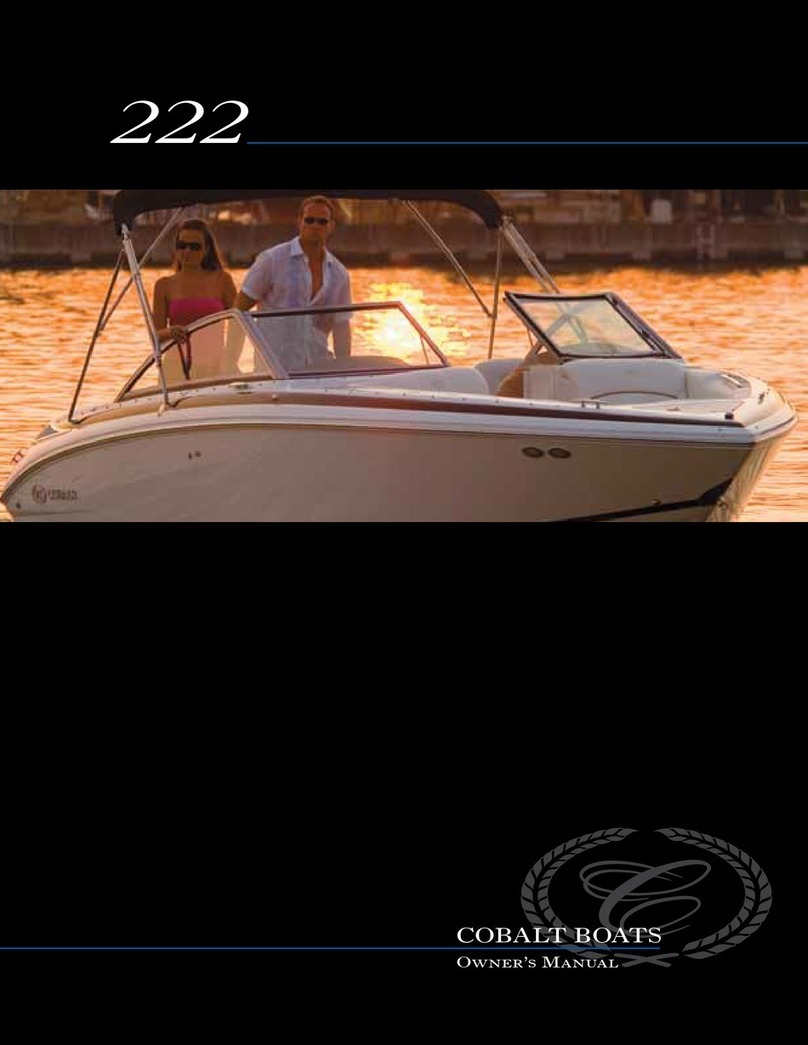
Cobalt Digital Inc
Cobalt Digital Inc 222 BOWRIDER owner's manual
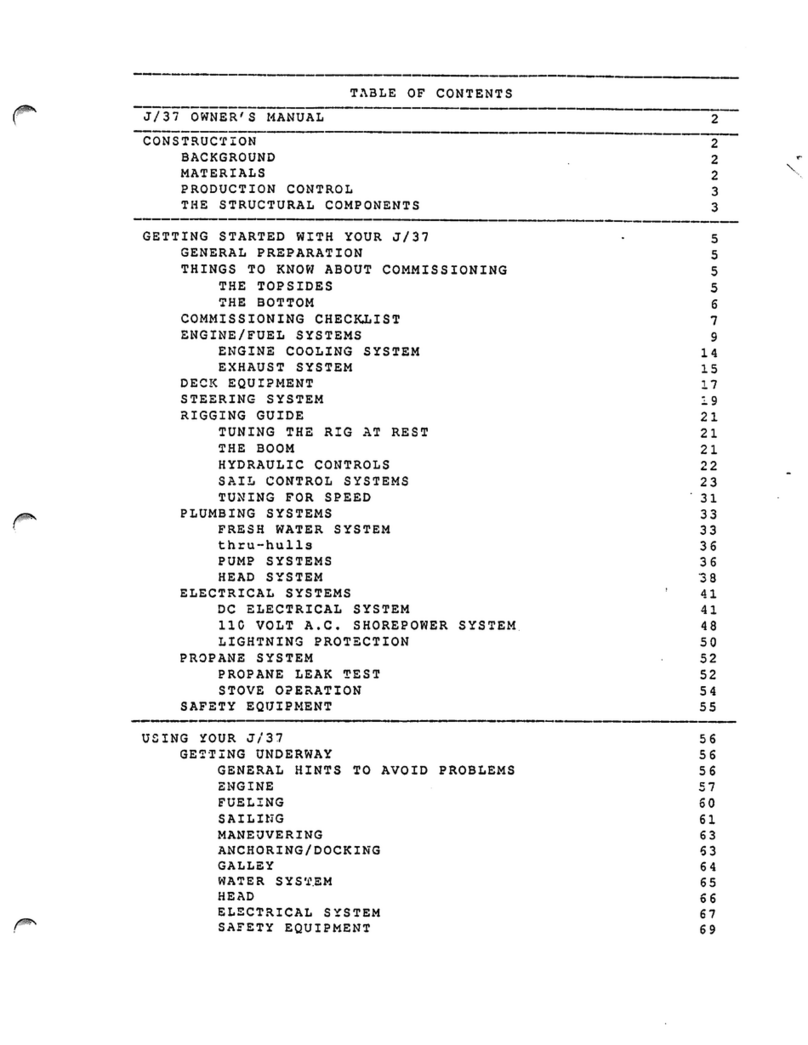
J/Boats
J/Boats J37 owner's guide
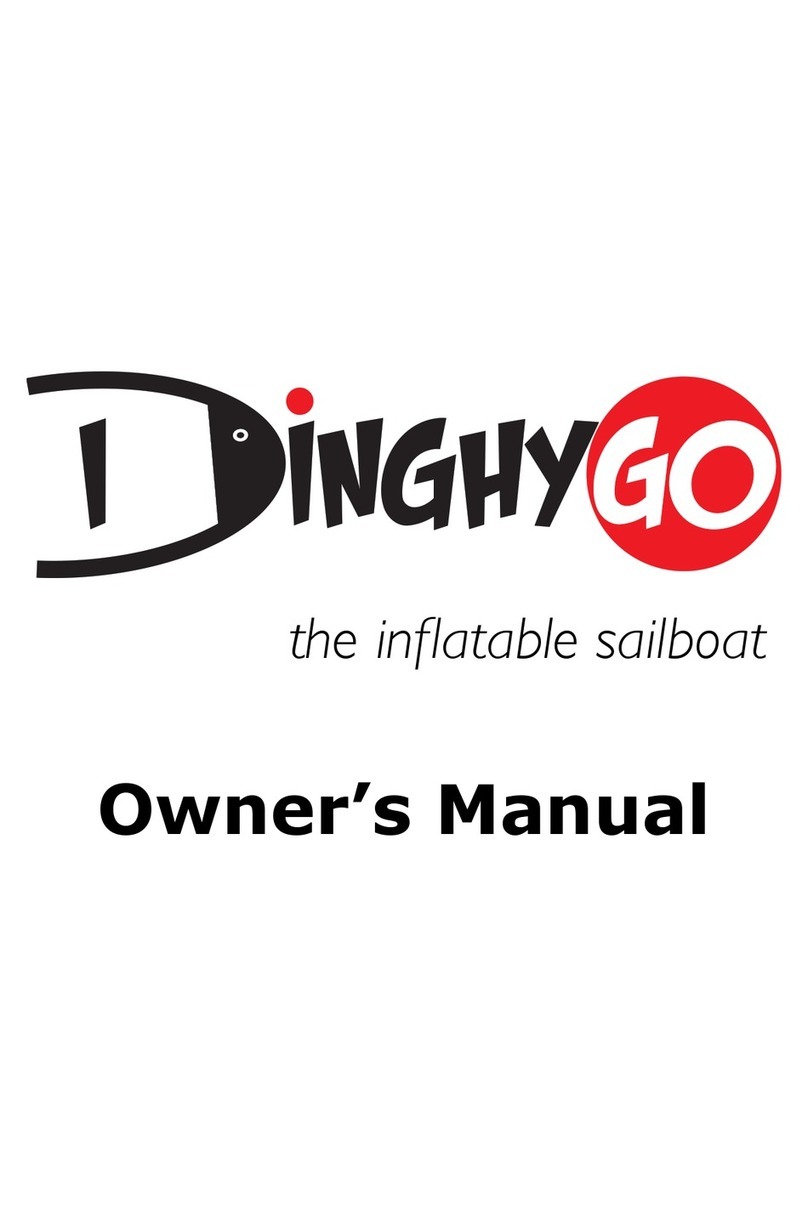
DinghyGo
DinghyGo Nomad 230 owner's manual

Grady-White Boats
Grady-White Boats ISLANDER 270 owner's manual
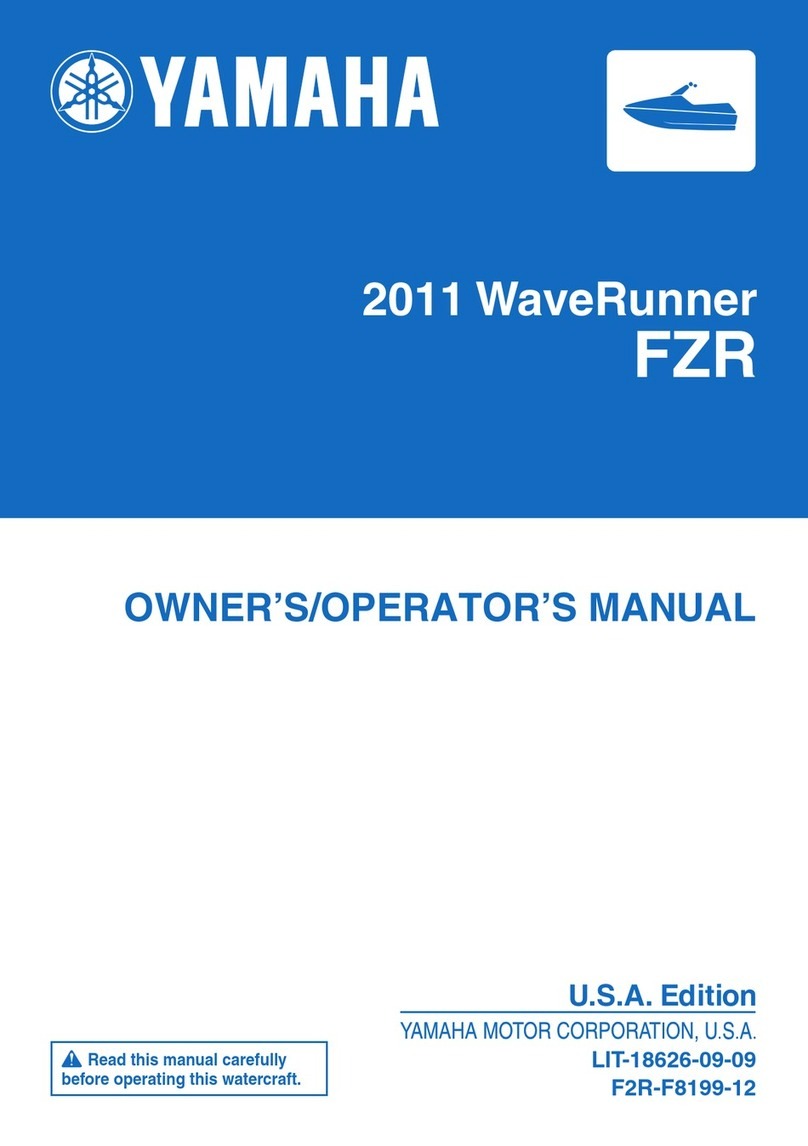
Yamaha
Yamaha 2011 WaveRunner FZR Owner's/operator's manual
